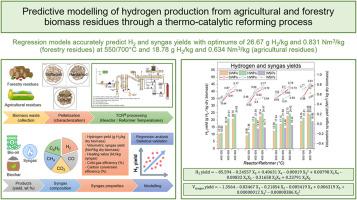Predictive modelling of hydrogen production from agricultural and forestry residues through a thermo-catalytic reforming process
IF 5.8
2区 生物学
Q1 AGRICULTURAL ENGINEERING
引用次数: 0
Abstract
Hydrogen produced from renewable sources is crucial for decarbonizing hard-to-abate sectors and achieving net-zero targets. This study examines hydrogen production through the novel thermo-catalytic reforming (TCR) process using agricultural and forestry residues. The research aims to develop and optimize regression models that integrate feedstock properties (ash, hydrogen-to-carbon molar ratio, and lignin) and process parameters (reactor and reformer temperatures) to predict yields of hydrogen (H2), syngas, methane (CH4) and carbon dioxide (CO2). Three biomass feedstocks – softwood pellets (SWPs), hardwood pellets (HWPs), and wheat straw pellets (WSPs) – were analyzed at reactor temperatures of 400–550 °C and reformer temperatures of 500–700 °C. Predictive models for H2 (R2 = 0.9642, RMSE = 1.0639) and syngas (R2 = 0.9894, RMSE = 0.0140) yields show strong agreement and accuracy between the predicted and experimental values. In contrast, the models for CH4 and CO2 yields show higher variability in the predictions. Reformer temperature was the most significant parameter influencing the yields of H2 and syngas. The optimal H2 yields predicted for the model were obtained for HWPs at 550/700 °C (26.67 g H2/kg dry biomass), followed by SWPs at 550/700 °C (24.11 g H2/kg dry biomass) and WSPs at 550/685.2 °C (18.78 g H2/kg dry biomass). The volumetric syngas yields were highest for HWPs at 550/700 °C (0.831 Nm3/kg dry biomass), followed by SWPs (0.777 Nm3/kg dry biomass) and WSPs (0.634 Nm3/kg dry biomass). This study demonstrates that regression modelling accurately predicts H2 and syngas yields, which would help to expand the applicability of TCR technology for large-scale hydrogen production, contributing to the decarbonization of the energy sector.

通过热催化重整过程从农业和林业残留物生产氢的预测模型
可再生能源生产的氢气对于使难以减排的部门脱碳和实现净零目标至关重要。本研究探讨了利用农业和林业废弃物通过新型热催化重整(TCR)工艺制氢。该研究旨在开发和优化回归模型,该模型集成了原料特性(灰分、氢碳摩尔比和木质素)和工艺参数(反应器和重整器温度),以预测氢气(H2)、合成气、甲烷(CH4)和二氧化碳(CO2)的产量。在400-550℃的反应器温度和500-700℃的转化炉温度下,对三种生物质原料——软木颗粒(SWPs)、硬木颗粒(HWPs)和小麦秸秆颗粒(WSPs)进行了分析。H2 (R2 = 0.9642, RMSE = 1.0639)和合成气(R2 = 0.9894, RMSE = 0.0140)产率的预测模型与实验值吻合较好,准确度较高。相比之下,CH4和CO2产率模型在预测中显示出更高的变异性。重整炉温度是影响H2和合成气产率最显著的参数。该模型预测的最佳氢气产量为:550/700°C的HWPs (26.67 g H2/kg干生物质),其次是550/700°C的SWPs (24.11 g H2/kg干生物质)和550/685.2°C的WSPs (18.78 g H2/kg干生物质)。在550/700°C时,HWPs的体积合成气产量最高(0.831 Nm3/kg干生物质),其次是SWPs (0.777 Nm3/kg干生物质)和WSPs (0.634 Nm3/kg干生物质)。该研究表明,回归模型可以准确预测H2和合成气产量,这将有助于扩大TCR技术在大规模制氢中的适用性,为能源部门的脱碳做出贡献。
本文章由计算机程序翻译,如有差异,请以英文原文为准。
求助全文
约1分钟内获得全文
求助全文
来源期刊

Biomass & Bioenergy
工程技术-能源与燃料
CiteScore
11.50
自引率
3.30%
发文量
258
审稿时长
60 days
期刊介绍:
Biomass & Bioenergy is an international journal publishing original research papers and short communications, review articles and case studies on biological resources, chemical and biological processes, and biomass products for new renewable sources of energy and materials.
The scope of the journal extends to the environmental, management and economic aspects of biomass and bioenergy.
Key areas covered by the journal:
• Biomass: sources, energy crop production processes, genetic improvements, composition. Please note that research on these biomass subjects must be linked directly to bioenergy generation.
• Biological Residues: residues/rests from agricultural production, forestry and plantations (palm, sugar etc), processing industries, and municipal sources (MSW). Papers on the use of biomass residues through innovative processes/technological novelty and/or consideration of feedstock/system sustainability (or unsustainability) are welcomed. However waste treatment processes and pollution control or mitigation which are only tangentially related to bioenergy are not in the scope of the journal, as they are more suited to publications in the environmental arena. Papers that describe conventional waste streams (ie well described in existing literature) that do not empirically address ''new'' added value from the process are not suitable for submission to the journal.
• Bioenergy Processes: fermentations, thermochemical conversions, liquid and gaseous fuels, and petrochemical substitutes
• Bioenergy Utilization: direct combustion, gasification, electricity production, chemical processes, and by-product remediation
• Biomass and the Environment: carbon cycle, the net energy efficiency of bioenergy systems, assessment of sustainability, and biodiversity issues.
 求助内容:
求助内容: 应助结果提醒方式:
应助结果提醒方式:


